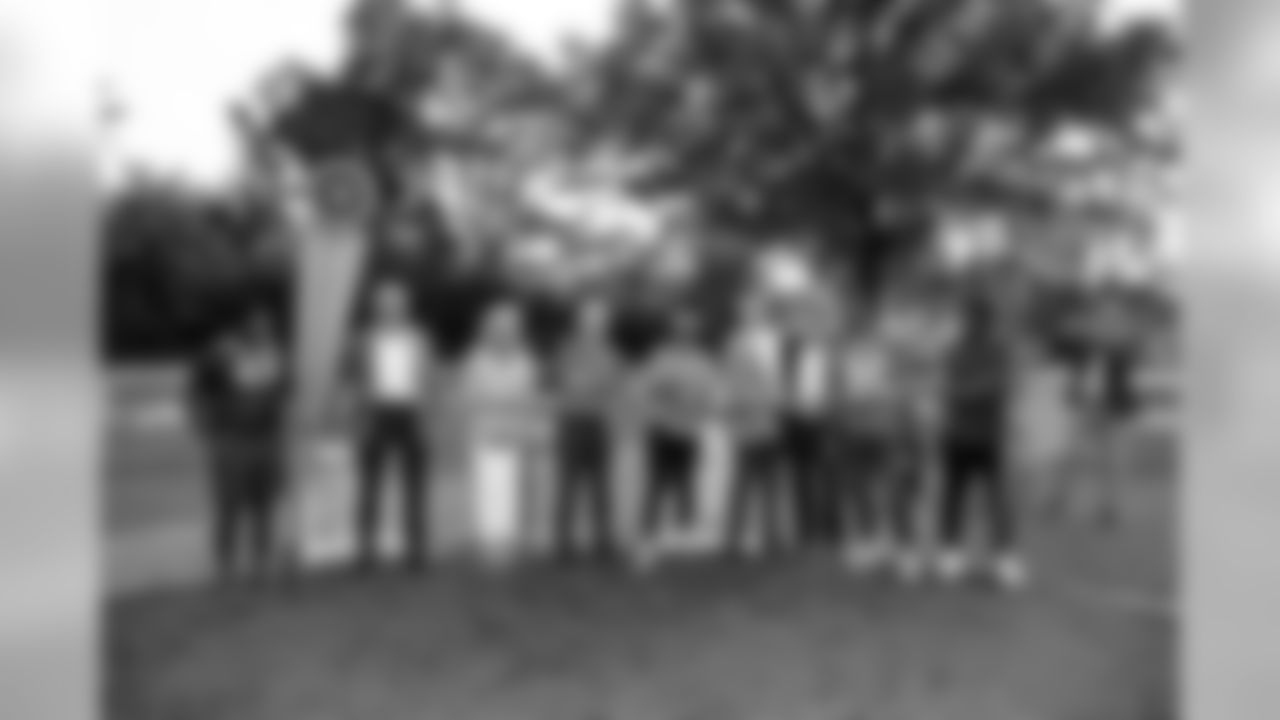When the Browns and Haslam family announced in 2016 that they would install five new turf fields in the Cleveland Metropolitan School District, they sought to leave a positive, decades-long impact on each school, their football program and the landscape of high school football around Northeast Ohio.
"Since making Cleveland our home, we have focused on improving football and education for the entire region," Jimmy and Dee Haslam said in a statement at the time. "By installing these five synthetic turf fields within CMSD, we are able to combine those two passions to give our youth, schools and communities year-round access to the resources they deserve."
Five years later, the effects of the project, which has included 11 fields and incorporated schools in Akron and Toledo, have been immense and changed the direction of several high school football programs and surrounding communities. From providing schools with a new, state-of-the-art playing surface for sports beyond football to helping some football programs nearly double in size, all of the fields have left a permanent footprint on the youth sports landscape in Ohio.
The project has also been a crucial piece of the "Get 2 School, Stay in the Game!" Network initiatives, which was established in 2019 to improve the attendance rates across 14 school districts and has since expanded to 16 districts. The initiative aims to break down several of the barriers that could keep students from regularly attending class. The network has already made a considerable footprint in Ohio and benefitted 100,000 students across the state in the 2020-21 school year.
Schools and organizations that have received fields include John F. Kennedy High School, James Ford Rhodes High School, Glenville High School, Lorain High School, Ellet Community Learning Center, John Marshall School of Information Technology, Start High School, John Adams Career and College Academy and Boys Hope Girls Hope. Shaw High School and Hoban High School are also in the process of installing new fields as well.
For some schools, the turf installations have given them their first home football field in several years. That was the case at John Marshall and John Adams, two high schools that spent years playing only away games as a result of having no football field on the school's campus. Players and coaches practiced at separate fields instead, some of which were in parks where violence and crime were prevalent. The fields were also covered with patches of dirt, poorly maintained and unfit for the intense conditions of football.
The lives of the programs changed once both fields were ready to use for the 2017 season. Both programs can devote more time to practice, host home games and welcome fans into bleachers for home games.
Jimmy Haslam and Dee Haslam visit Boys Hope Girls Hope for the dedication of Haslam Field

Jimmy Haslam and Dee Haslam visit Boys Hope Girls Hope for the dedication of Haslam Field

Jimmy Haslam and Dee Haslam visit Boys Hope Girls Hope for the dedication of Haslam Field

Jimmy Haslam and Dee Haslam visit Boys Hope Girls Hope for the dedication of Haslam Field

Jimmy Haslam and Dee Haslam visit Boys Hope Girls Hope for the dedication of Haslam Field

Jimmy Haslam and Dee Haslam visit Boys Hope Girls Hope for the dedication of Haslam Field

Jimmy Haslam and Dee Haslam visit Boys Hope Girls Hope for the dedication of Haslam Field

Jimmy Haslam and Dee Haslam visit Boys Hope Girls Hope for the dedication of Haslam Field

Jimmy Haslam and Dee Haslam visit Boys Hope Girls Hope for the dedication of Haslam Field

Jimmy Haslam and Dee Haslam visit Boys Hope Girls Hope for the dedication of Haslam Field

Jimmy Haslam and Dee Haslam visit Boys Hope Girls Hope for the dedication of Haslam Field

Jimmy Haslam and Dee Haslam visit Boys Hope Girls Hope for the dedication of Haslam Field

Jimmy Haslam and Dee Haslam visit Boys Hope Girls Hope for the dedication of Haslam Field

Jimmy Haslam and Dee Haslam visit Boys Hope Girls Hope for the dedication of Haslam Field

Jimmy Haslam and Dee Haslam visit Boys Hope Girls Hope for the dedication of Haslam Field

Jimmy Haslam and Dee Haslam visit Boys Hope Girls Hope for the dedication of Haslam Field

Jimmy Haslam and Dee Haslam visit Boys Hope Girls Hope for the dedication of Haslam Field

Jimmy Haslam and Dee Haslam visit Boys Hope Girls Hope for the dedication of Haslam Field

Jimmy Haslam and Dee Haslam visit Boys Hope Girls Hope for the dedication of Haslam Field

Jimmy Haslam and Dee Haslam visit Boys Hope Girls Hope for the dedication of Haslam Field

Jimmy Haslam and Dee Haslam visit Boys Hope Girls Hope for the dedication of Haslam Field
"I think it's a point of pride for the whole neighborhood," said John Marshall athletic director Joe Gilbert, who also noted that the football team's size has grown from 15 players to 40 players since the field was installed.
"We can roll out the back door now to get to the field. This field has added so much to what we can be. It has been part of a renaissance here, and it's been phenomenal."
John Adams, meanwhile, is thankful to end the days of playing on a hard, dirt practice field, one that didn't always have yard-lines painted and was like "playing in the stone age."
"I literally shed tears," coach Gary Jackson said when he remembered when the turf was installed. "I knew what the new field was going to mean to not only our kids, but to the entire community. Our kids can now play in front of their friends. It's made a major, major impact."
The fields have benefitted more than just high schools.
The Muny Football League, a youth organization that uses local high school fields for games and practices, has seen a 7-10 percent increase in participation in part because of the turf fields, which is more attractive to the eyes of young and aspiring kids looking to play on a similar surface as their NFL idols. The league also serves as a feeder program for high schools in the area and has even been able to start a flag football league, which has grown from roughly 100 kids in 2017 to around 700 in 2021.
"You have the mantra 'You look good, you play' good, and that holds true for football facilities," Muny League director Jason Dunn said. "When you're playing on a turf field, that's going to hold more interest than playing on a grassy or dirt field. It's been a huge benefit for us."
For nearly all of the schools, the new fields, which include a two Browns helmet logos at the 25-yard lines, have eased maintenance responsibilities to school staffers and coaches who would constantly need to water and mow the grass. Many of the schools only allowed football teams to use their fields in order to ensure they could be properly maintained, but now other school sports, bands, cheerleading teams and other community organizations can use the fields and take advantage of the elite playing surface turf offers athletes.
"It makes (students) feel special," said Heather O'Neill, who has been a security officer at Rhodes High School and has worked at the school for 10 years and has formed close bonds with students on the team. As players walked off the field on a hot summer day in July, they stopped by O'Neill, gave her a hug and chatted about what they're doing next after practice.
"Playing on a field like this is just the best feeling for them," she said. "The field makes them feel as though people are watching. They need that in their lives. They need that for their morale. It makes them feel like they're doing something important."
At Boys Hope Girls Hope, a Garfield Heights academy that assists students 12-24 years old from under-resourced communities with long-term support and partnership focused on preparing each scholar for post-secondary and career success, the 70-yard turf field has helped the academy provide their scholars with athletic opportunities and create a significant extension from the resources the academy already provided.
Even though BHGH doesn't have individual sports teams, the turf field has offered its scholars an opportunity to join other youth leagues who use the field, which BHGH offers with no fee. When a youth tackle football or soccer programs have asked to use the field, they allow scholars from BHGH to join the fun.
"That's been the way our kids have been able to participate in something they otherwise would never be doing," BHGH Executive Director Tim Grady said. "We were really proud that the Browns felt we were appropriate and worthy for that investment."
Every school has reaped the benefits of their new turf field in different ways. The one constant, however, is that every school has cherished a new area for their students to grow, exercise and take advantage of all the positive school sports can offer.
"This field has just added so much to what we can be," Gilbert said. "When we got this field, I said, 'I want to fill this field.' I want to use it, and that's what we've been doing. There's something going on here every day. This has been a godsend for us."















